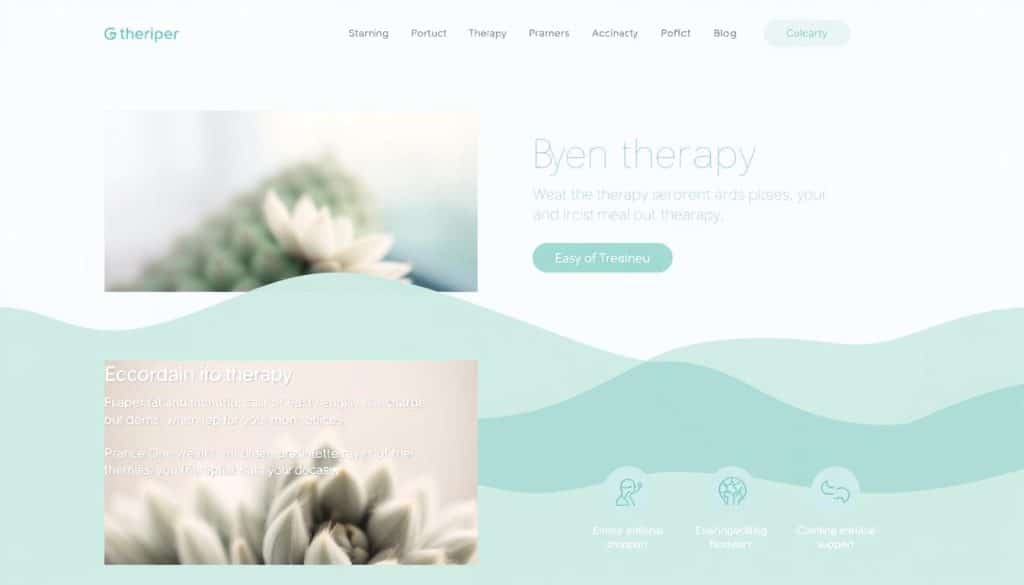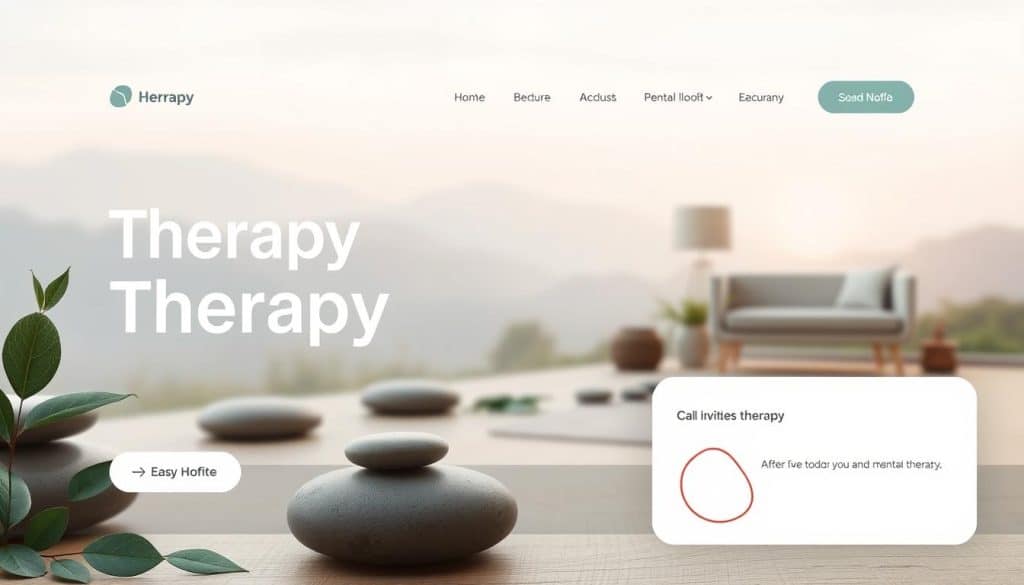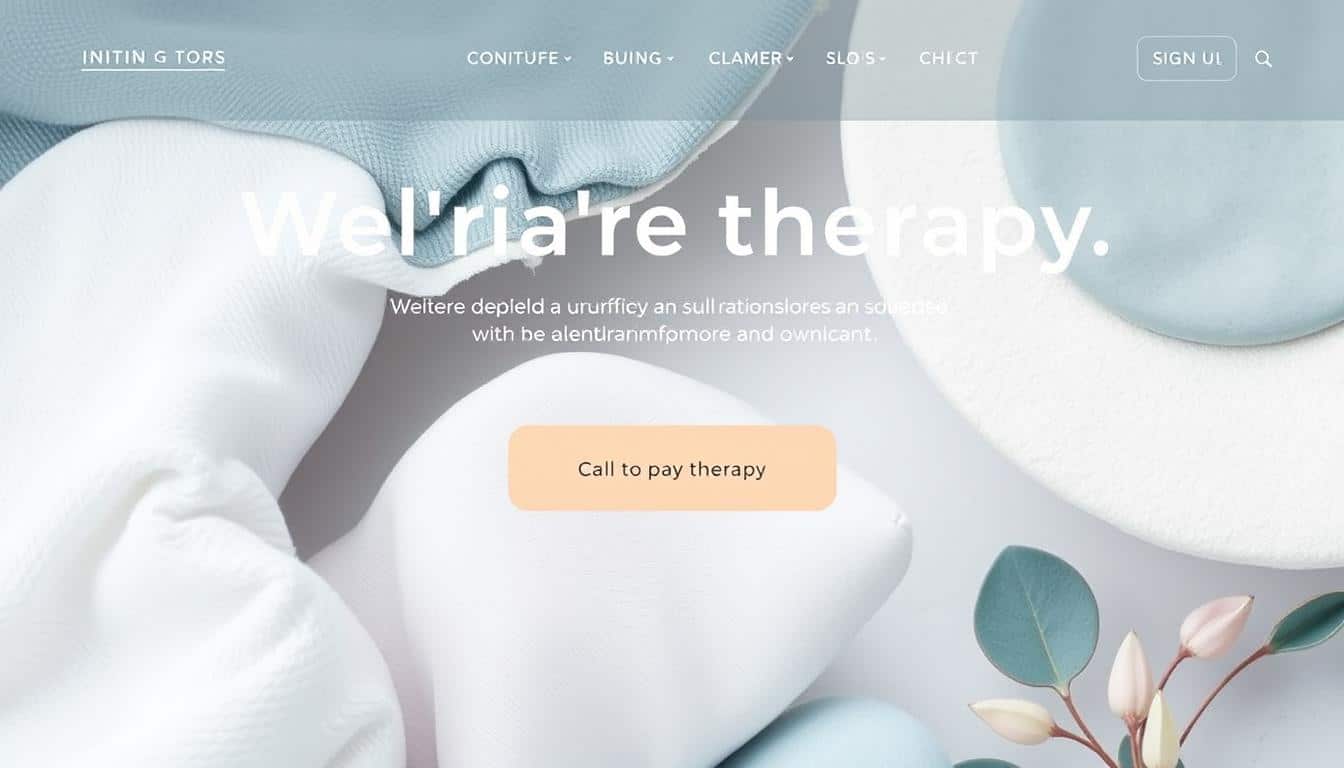In today’s world, a good therapy website is key to attracting clients. As a mental health expert, your website is a bridge to those who need your help. By using therapy website design tips, you can make a site that’s easy to use, looks great, and connects with your audience.
Your website is the first thing clients see, so it’s very important. It should be easy to navigate and have great content. Every part of your website helps your practice grow.
Key Takeaways
- Prioritize website usability and user-friendly navigation to enhance the client experience
- Develop engaging and informative content that resonates with your target audience
- Ensure your website is responsive and accessible across devices for optimal user experience
- Leverage online therapy platforms to streamline virtual counseling services
- Establish a professional and trustworthy brand identity to convey your expertise
Crafting a User-Friendly Therapy Website
Creating a therapy website that connects with your audience is key to a strong online presence. It helps attract potential clients. At the core of a successful website is website usability, which boosts the user experience.
The Importance of Website Usability
Website usability measures how easy it is for users to navigate and interact with your site. A user-friendly site helps visitors find what they need fast. It also builds trust in your practice.
By focusing on usability, you ensure a smooth experience. This keeps visitors engaged and encourages them to book appointments or contact you.
Optimizing Navigation and Site Structure
Good navigation and a clear site structure are vital for a user-friendly website. Organize your content in a way that’s easy to follow. Use a simple menu with clear labels and direct paths to important pages.
Also, add features like a search function or a “Find a Therapist” tool. These enhance the user experience and help visitors find what they need quickly. A well-organized website is both attractive and functional, meeting your audience’s needs.
| Website Usability Factors | Therapy Website Design Tips |
|---|---|
| Intuitive Navigation | Implement a clear, concise menu structure with logical labeling |
| Mobile-Friendly Design | Ensure your website is responsive and optimized for various devices |
| Accessibility | Prioritize accessibility features to accommodate users with disabilities |
| Content Organization | Organize your content in a logical and easy-to-follow manner |
| Visual Aesthetics | Create a visually appealing design that aligns with your brand identity |
A user-friendly therapy website is crucial for a positive visitor experience. It’s also vital for your practice’s success. By focusing on usability, you create a digital space that showcases your expertise, builds trust, and encourages potential clients to seek your help.
Engaging Your Audience with Compelling Content
In the world of therapy website development, making engaging and informative content is key. Whether you’re a psychologist, therapist, or mental health expert, your website is like a digital storefront. It invites people to learn about your skills and services. By creating compelling content, you can build trust, show your credibility, and encourage visitors to seek your help.
Your website should connect with your audience on a personal level. Show your qualifications and also your empathy and desire to help. Engaging therapy website content that speaks to your visitors can make you stand out. It also increases the chance they’ll reach out for your services.
Crafting Relevant and Informative Content
To grab your audience’s attention, make content that’s both relevant and informative. Therapist website best practices say to tackle common concerns and questions. By sharing valuable insights and tips, you show your expertise. This makes you a trusted source in mental health web design.
- Write in-depth articles and blog posts on mental health topics like anxiety, depression, or relationship issues.
- Provide educational resources, like self-care guides or coping strategies, to help your visitors.
- Include patient testimonials or case studies to show the impact of your psychology website development services.
Fostering Emotional Connection
It’s also important to build an emotional connection with your visitors. Engaging therapy website content should reflect your personal approach and values. Share your passion for helping others, your inspirations, and the compassionate philosophy of your practice.
“The most powerful way to connect with your audience is through authentic, heartfelt storytelling.”
By adding personal stories and insights to your content, you can make your brand more relatable. This builds trust and rapport with potential clients.

Remember, effective psychology website development is about more than just showing your qualifications. It’s about building a meaningful connection with those seeking your help. By creating compelling and personalized content, you can attract your audience and make your therapy practice a trusted partner in their journey to well-being.
Responsive Design for Optimal User Experience
In today’s world, making sure your therapy website works well on all devices is key. Responsive design is now a must for mental health sites. This is because people often look up info on their phones, tablets, and computers.
Enhancing Accessibility Across Devices
A responsive website looks great on any screen size. It makes your site easy to use and nice to look at, no matter the device. By focusing on website usability, you make it easy for visitors to find what they need. This helps your counseling website work better.
Prioritizing Mobile-Friendly Design
Most of your website visitors will be on smartphones and tablets. Having a mobile-friendly design means your site meets their needs. It makes sure they can easily find what they’re looking for. This not only makes your site better for mobile users but also helps more people engage with your services.
| Device | Percentage of Website Traffic | Importance of Responsive Design |
|---|---|---|
| Smartphone | 60% | High |
| Tablet | 20% | Moderate |
| Desktop | 20% | High |
“A responsive website design is no longer a luxury, but a necessity in today’s mobile-driven world. Embracing this approach ensures your therapy practice remains accessible and engaging for all your potential clients, regardless of their device of choice.”
Therapy Website Design Tips: Boost Your Practice
Creating a great therapy website is key to attracting new clients and growing your practice. The right web design can make your online presence stand out. It shows your expertise to your target audience. Here, we’ll share top tips to boost your practice and reach more clients.
Optimize for User Experience
Make sure your website is easy to use. Focus on simple navigation, clear calls-to-action, and easy access to important info like services and contact details. A user-friendly site builds trust and credibility with your clients.
Leverage Visually Appealing Imagery
Use high-quality, engaging images to enhance your website’s look and message. Choose images that show warmth, empathy, and professionalism, matching your practice’s unique character. Opt for real photos of your team and office instead of generic stock images.
Showcase Your Expertise
Highlight your credentials, specialized areas, and any awards or recognition. This shows you’re a qualified professional. It reassures potential clients that they’re in good hands with you.

By following these design tips, you can make a website that attracts clients and builds trust. A well-designed site is a powerful tool for growing your practice. It helps you reach those who need your support.
Integrating Online Therapy Platforms
In today’s digital world, adding online therapy platforms to your mental health website is key. It makes virtual counseling smooth for your clients. This meets their changing needs and keeps your practice ahead in website optimization.
Streamlining Virtual Counseling Services
Adding online therapy platforms to your site can change how you offer mental health services. Here are important steps for a smooth virtual counseling experience:
- Intuitive Scheduling: Use easy-to-use scheduling tools for clients to book and manage sessions.
- Secure Video Conferencing: Make sure your platform has secure and reliable video calls for a private space.
- Comprehensive Client Portal: Create a portal for clients to access recordings, track progress, and talk to their therapist securely.
- Smooth Onboarding: Make it easy for new clients to sign up and start their online therapy account.
Focus on these points to make virtual counseling smooth. This improves the user experience and builds a strong bond with your clients.
| Feature | Benefit |
|---|---|
| Intuitive Scheduling | Allows clients to easily book and manage sessions, enhancing the user experience. |
| Secure Video Conferencing | Ensures a private space for counseling, building trust and confidentiality. |
| Comprehensive Client Portal | Provides easy access to recordings, progress, and secure communication, boosting engagement. |
| Smooth Onboarding | Makes it simple for new clients to start virtual counseling, improving access. |
By integrating online therapy platforms into your website, you improve the user experience. You also make virtual counseling smoother and keep your practice at the top in counseling website optimization.
Building Trust with Professional Branding
In the world of mental health web design, having a professional and trustworthy brand is key. Your website is like a digital mirror of your practice. It’s important to show your expertise and credibility to potential clients. By following therapist website best practices, you can build a strong brand that people can trust.
Conveying Expertise and Credibility
Showing off your qualifications, certifications, and experience is crucial. Display your credentials and any awards you’ve won to show you’re an expert. Also, using testimonials from happy clients can boost your credibility and the quality of your services.
Using consistent and attractive branding, like a good logo and colors, makes your site look professional. This helps create a strong online presence that matches your offline brand. It makes your website memorable for visitors.
| Branding Element | Importance |
|---|---|
| Logo Design | Establishes a recognizable visual identity and reinforces your brand’s personality. |
| Color Palette | Evokes specific emotions and associations, helping to differentiate your practice. |
| Typography | Contributes to the overall aesthetic and readability of your counseling website optimization. |
By carefully crafting your professional branding, you can show your expertise and credibility. This builds trust with your website visitors and helps your practice succeed.
Embracing Best Practices for Mental Health Web Design
Your website is key in reaching out to your clients and building a supportive online space. In mental health web design, focus on making your site user-friendly. It should meet the special needs of your therapy or counseling service.
For therapy website design tips, aim for a calm and peaceful look. Use soft colors, simple designs, and few distractions. This helps visitors feel safe and relaxed. Also, make sure your site is easy to navigate and that visitors can find what they need quickly. This is crucial for user experience for therapy sites.
- Make your site easy to use by organizing it well. This helps visitors find what they need without trouble.
- Use simple and clear language. Avoid complicated terms that might confuse your audience.
- Show off your skills and qualifications in a friendly way. This builds trust and credibility with your visitors.
By following these best practices for mental health web design, you can make a website that draws in and keeps your target audience. It will also show the caring and supportive nature of your practice.
“Your website should be a reflection of the care and attention you provide to your clients.”
Optimizing for Search Engines and Discoverability
Your therapy website’s visibility on search engines is key in today’s digital world. By using SEO strategies for therapy websites, you can make sure people find your practice. This section will guide you on how to boost your online presence and draw in the right clients.
SEO Strategies for Therapy Websites
Building a strong SEO foundation is vital for your website’s success. Begin by making your site’s content rich with keywords like “therapy website design tips” and “counseling website optimization.” Use these keywords in your titles, descriptions, and text to improve your search rankings.
Don’t forget about off-page SEO. This includes getting backlinks from trusted sites, being active on social media, and using local SEO. A balanced SEO approach will help more people find your practice, bringing in new clients.



